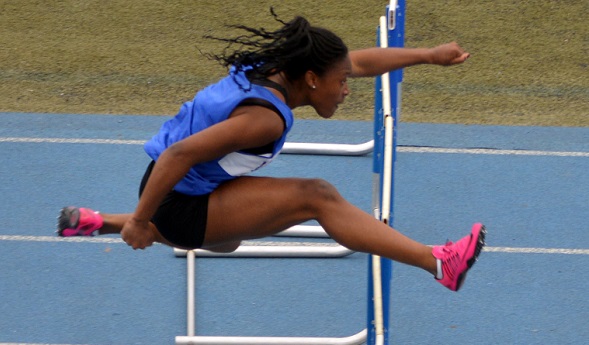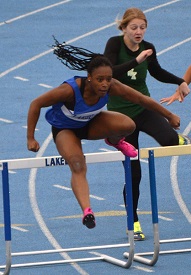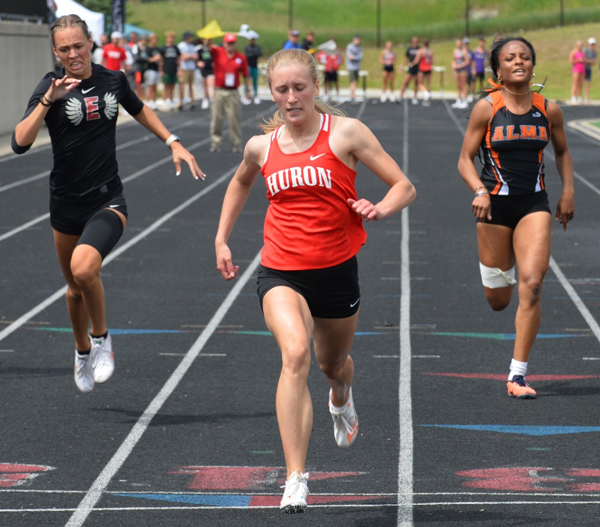
Performance: Lakeland's Grace Stark
June 2, 2017
 Grace Stark
Grace Stark
White Lake Lakeland sophomore – Track & Field
The Eagles’ speedy standout has made significant strides – literally – this season, cutting more than a second off her fastest 100-meter hurdles time from 2016. How much she’s improved in that race gained the most notice at Friday’s Oakland County Championships when Stark won in 13.54 seconds, earning the Michigan Army National Guard “Performance of the Week.” If she can repeat that time at Saturday’s Lower Peninsula Division 1 Finals, she’ll break the all-Finals record set by Ann Arbor Pioneer’s Candice Davis in 2003.
Stark’s fastest 100 hurdles time as a freshman was 14.64 seconds, and she also ran 11.82 in the 100 dash. She approached the dash personal record as well at the Oakland County meet, winning in 11.86. She’s undefeated in both the 100 dash and 100 hurdles this season, plus won a Regional title in the 200 in a personal-record 24.99 seconds. Stark owns Lakeland’s records in the 100, 100 hurdles and 200 and as part of the 400 and 800 relays, the last two helped of course by a number of talented teammates, including a strong senior class finishing up this weekend.
 After developing bursitis in a hip over the summer, Stark took six weeks off from training. She upped her workouts to near-normal in December and competed indoor before showing her advancing speed on the outdoor track. Also a gymnast during elementary and middle school, Stark focuses solely on track now but said her time on the mat helped her improve physically and become more disciplined. She carries a 3.9 grade-point average, showing discipline and determination in the classroom as well.
After developing bursitis in a hip over the summer, Stark took six weeks off from training. She upped her workouts to near-normal in December and competed indoor before showing her advancing speed on the outdoor track. Also a gymnast during elementary and middle school, Stark focuses solely on track now but said her time on the mat helped her improve physically and become more disciplined. She carries a 3.9 grade-point average, showing discipline and determination in the classroom as well.
Coach John Kababik said: "Grace is the fastest sprinter that I have coached in 40 years of coaching Lakeland girls track. What makes her so good is not only the talent she was born with, but the single-minded determination to be the best. She runs track both in season and out as a club runner. Grace was very good as a freshman, but she has improved by a full second over the last year in the hurdles. For sprinters to improve that much is not common. She came into high school fast, but she’s getting better due to the fact she’s so conscious of her technique. She’s just driven. She wants to be better, and she’s so knowledgeable that she’ll talk to me about former Olympic champions and the techniques they used. Grace will continue to break records and improve because that is who she is: that is part of her personality."
Performance Point: “I think I had a better start that day,” Stark said of the Oakland County hurdles race. “I got out to the first hurdle, and actually I’ve been working on my arms – working on not raising over hurdles, but keeping them low and right in front of me. … I thought I’d pulled off a good time, but I didn’t know it was good enough for a state record. I hit the last hurdle, and I didn’t know how much that slowed me down.”

Give it up for Gail: “Gail Devers (a U.S. Olympic gold medalist in 1992 and 1996), she did the 100 and she did the hurdles too, and she’s the big person I look up to. I’ve been told she has a similar body structure to me, so I thought, well, she’s my height, she did the hurdles and the dash, so she’s very similar to me. And she’s someone I’ve been told to watch by my coaches."
Mat time pays off: “(Gymnastics) made me stronger, my whole body. I did a lot of sprints toward the vault table, and I thought that helped. And the technique we had; it taught me a lot about discipline, helped me prevent injuries, all the workouts that we did.”
Fun to be fast: “I like the pressure of (racing). I like being out on the line, going off and being in the race. I like the thrill of it, really. Not knowing who is going to win, how the race is going to turn out. And giving all of yourself to something you care about is really fun.”
Difference in the details: “I take time with things, make sure they’re done right before I finish them. I think that reflects in both (athletics and academics) how I get stuff done. I’m very critical of myself. If it’s not done almost perfect, I find something to work on or something to fix.”
- Geoff Kimmerly, Second Half editor
Every week during the 2016-17 school year, Second Half and the Michigan Army National Guard will recognize a “Performance of the Week" from among the MHSAA's 750 member high schools.
The Michigan Army National Guard provides trained and ready forces in support of the National Military Strategy, and responds as needed to state, local, and regional emergencies to ensure peace, order, and public safety. The Guard adds value to our communities through continuous interaction. National Guard soldiers are part of the local community. Guardsmen typically train one weekend per month and two weeks in the summer. This training maintains readiness when needed, be it either to defend our nation's freedom or protect lives and property of Michigan citizens during a local natural disaster.
Previous 2016-17 honorees:
May 25: Brendon Gouin, Gaylord golf – Read
May 18: Hannah Ducolon, Bay City All Saints softball – Read
May 11: Mason Phillips, Salem track & field – Read
May 4: Lillian Albaugh, Farwell track & field – Read
April 27: Amber Gall, Shepherd track & field – Read
April 20: Sloane Teske, East Grand Rapids tennis – Read
March 30: Romeo Weems, New Haven basketball – Read
March 23: Jaycie Burger and Maddie Clark, Pittsford basketball – Read
March 16: Camden Murphy, Novi swimming & diving – Read
March 9: Ben Freeman, Walled Lake Central wrestling – Read
March 2: Joey Mangner, Chelsea swimming & diving – Read
Feb. 23: Isabelle Nguyen, Grosse Pointe North gymnastics – Read
Feb. 16: Dakota Hurbis, Saline swimming & diving – Read
Feb. 2: Foster Loyer, Clarkston basketball – Read
Jan. 26: Nick Jenkins, Detroit Catholic Central wrestling – Read
Jan. 19: Eileene Naniseni, Mancelona basketball – Read
Jan. 12: Rory Anderson, Calumet hockey – Read
Dec. 15: Demetri Martin, Big Rapids basketball – Read
Dec. 1: Rodney Hall, Detroit Cass Tech football – Read
Nov. 24: Ally Cummings, Novi volleyball – Read
Nov. 17: Chloe Idoni, Fenton volleyball – Read
Nov. 10: Adelyn Ackley, Hart cross country – Read
Nov. 3: Casey Kirkbride, Mattawan soccer – Read
Oct. 27: Colton Yesney, Negaunee cross country – Read
Oct. 20: Varun Shanker, Midland Dow tennis – Read
Oct. 13: Anne Forsyth, Ann Arbor Pioneer cross country – Read
Oct. 6: Shuaib Aljabaly, Coldwater cross country – Read
Sept. 29: Taylor Seaman, Brighton swimming & diving – Read
Sept. 22: Maggie Farrell, Battle Creek Lakeview cross country – Read
Sept. 15: Franki Strefling, Buchanan volleyball – Read
Sept. 8: Noah Jacobs, Corunna cross country – Read
PHOTO: (Top) White Lake Lakeland's Grace Stark clears a hurdle during a race this season. (Middle) Stark begins to break away from the pack. (Action photos courtesy of the White Lake Lakeland athletic department; head shot courtesy of the Oakland Press.)

Multi-Sprint Champ Racing to Finish Huron Career Ahead of the Rest Again
By
Keith Dunlap
Special for MHSAA.com
May 25, 2023
NEW BOSTON – If there was one thing Elizabeth Anderson took pride in elementary school, it was simply showing that she could outrun everyone in sight.
 In fact, Anderson has an explanation for all the success she had in those playground races.
In fact, Anderson has an explanation for all the success she had in those playground races.
“Dominance when you are in elementary school,” Anderson quipped. “I don’t think I ever had a nickname. I just think everyone knew I was fast.”
Years later, pretty much everyone who follows track & field in the state of Michigan can attest to that.
A senior for New Boston Huron, Anderson has been faster than most other competitors in the state during her three-year high school career (with her freshman season in 2020 canceled due to COVID-19).
Last year, Anderson won titles at the Lower Peninsula Division 2 Finals in the 200-meter (25.07) and 400-meter (56.28) dashes, and was runner-up in the 100-meter dash (12.23).
Often, top sprinters focus on one or two of those three races. But Anderson is certainly a different breed of sprinter because she does all three.
In fact, she holds school records in all three of those events, and if all that weren’t enough, Anderson is a part of all three sprint relay teams.
“It is hard to give her events off,” said New Boston Huron head girls track coach Danielle Lobato.
Despite the different styles the 100, 200 and 400-meter dashes present, Anderson said there usually isn’t much adjusting when she goes from one of those races to another.
 The strategy is simply, “Let’s beat the other girls to the finish line.”
The strategy is simply, “Let’s beat the other girls to the finish line.”
“I don’t really go into each race changing up how I would run,” she said.
While enjoying and succeeding in all three races, Anderson said she actually does have a favorite among them.
“I would say the 400 is probably my favorite,” she said. “Even though it hurts, it’s satisfying to see how much you can get your time down in the 400 compared to any other race.”
Anderson said she started running track in sixth grade, but really got serious about it during the summer after her sophomore season, when she was invited to run for a local club.
Eventually, that led to her competing over the winter in indoor events.
She lived and breathed track so much that last fall, she decided to not run cross country so she could focus on a weightlifting regimen aimed at developing more leg strength.
“Once I started doing summer track, I realized I wanted to be doing this all the time,” she said.
Lobato said oftentimes in practice, Anderson is a de facto coach, given there is no better person she can think of for the younger runners on the team to learn from.
“I can’t always demonstrate these things I’m trying to teach,” she said. “You get to see it in real life (from Anderson), not in a YouTube video.”
After winning the 100, 200 and 400-meter dashes at her Regional meet last week, Anderson has her sights set on achieving the same trifecta of titles at next Saturday’s Finals in Grand Rapids.
Anderson has signed to run track at Michigan State, but has been plenty motivated to keep producing this spring in her final high school season.
“I’m really looking to defend my titles,” she said. “That is what is really motivating me to keep going. I want to keep in shape for the college season. I don’t want to lose any of the progress I have made. Ultimately, I just love running track.”
And since elementary school, Anderson has loved — and succeeded in — outrunning everyone else to the finish line.
“We knew we were getting something special,” Lobato said of when Anderson arrived in high school. “But you never expect this. All that she has accomplished is amazing.”
 Keith Dunlap has served in Detroit-area sports media for more than two decades, including as a sportswriter at the Oakland Press from 2001-16 primarily covering high school sports but also college and professional teams. His bylines also have appeared in USA Today, the Washington Post, the Detroit Free Press, the Houston Chronicle and the Boston Globe. He served as the administrator for the Oakland Activities Association’s website from 2017-2020. Contact him at [email protected] with story ideas for Oakland, Macomb and Wayne counties
Keith Dunlap has served in Detroit-area sports media for more than two decades, including as a sportswriter at the Oakland Press from 2001-16 primarily covering high school sports but also college and professional teams. His bylines also have appeared in USA Today, the Washington Post, the Detroit Free Press, the Houston Chronicle and the Boston Globe. He served as the administrator for the Oakland Activities Association’s website from 2017-2020. Contact him at [email protected] with story ideas for Oakland, Macomb and Wayne counties
PHOTOS (Top) New Boston Huron's Elizabeth Anderson clears the finish line during last season's LPD2 400 race. (Middle) Anderson, middle, outpaces the field to also win the 200. (Click for more from RunMichigan.com.)

